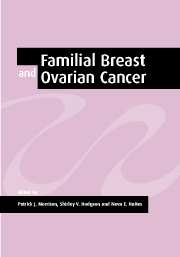Book contents
- Frontmatter
- Contents
- List of contributors
- Foreword by Helena Kennedy
- Preface
- Acknowledgements
- Part 1 Molecular biology and natural history
- 1 Introduction
- 2 Overview of the clinical genetics of breast cancer
- 3 Cowden syndrome and related disorders
- 4 Overview of the clinical genetics of ovarian cancer
- 5 Ovarian and breast cancer as part of hereditary non-polyposis colorectal cancer (HNPCC) and other hereditary colorectal cancer syndromes
- 6 The natural history of hereditary breast cancer
- 7 Pathology of the breast and ovary in mutation carriers
- 8 Risk estimation for familial breast and ovarian cancer
- Part 2 Screening
- Part 3 Management
- Index
1 - Introduction
Published online by Cambridge University Press: 24 August 2009
- Frontmatter
- Contents
- List of contributors
- Foreword by Helena Kennedy
- Preface
- Acknowledgements
- Part 1 Molecular biology and natural history
- 1 Introduction
- 2 Overview of the clinical genetics of breast cancer
- 3 Cowden syndrome and related disorders
- 4 Overview of the clinical genetics of ovarian cancer
- 5 Ovarian and breast cancer as part of hereditary non-polyposis colorectal cancer (HNPCC) and other hereditary colorectal cancer syndromes
- 6 The natural history of hereditary breast cancer
- 7 Pathology of the breast and ovary in mutation carriers
- 8 Risk estimation for familial breast and ovarian cancer
- Part 2 Screening
- Part 3 Management
- Index
Summary
It has long been recognized that some very rare forms of cancer, such as retinoblastoma and neurofibromatosis, are caused by inherited genes. It is only within the last few years, however, that rapid progress has been made in understanding the role that inherited genes also play in determining a proportion of the more common cancers, including breast, colorectal and ovarian cancer. Although there is still uncertainty about the precise contribution of inherited predisposition genes to the incidence of these cancers, the available evidence suggests that breast, colorectal and ovarian cancer have a number of common genetic features.
A small proportion of these cancers (about 5%) are caused by inherited genes which, though comparatively rare, confer very high lifetime risks of developing cancer. In some cases these lifetime risks may be as high as 80%.
Cancers caused by these high penetrance genes are more likely to occur at an early age than sporadic cancers, and 15–20% of the cancers diagnosed in people under the age of 50 years may be accounted for by these genetic mutations.
Carriers of known genetic mutations, which confer high lifetime risks of developing breast or ovarian cancer, are also at significantly increased risk of developing certain other forms of cancer.
A further 10–20% of breast, ovarian and colorectal cancers are likely to be caused by inherited polymorphisms in predisposition genes, which are commoner but less penetrant but which confer some increased risk (more than three times the general population risk).
[…]
- Type
- Chapter
- Information
- Familial Breast and Ovarian CancerGenetics, Screening and Management, pp. 3 - 5Publisher: Cambridge University PressPrint publication year: 2002



